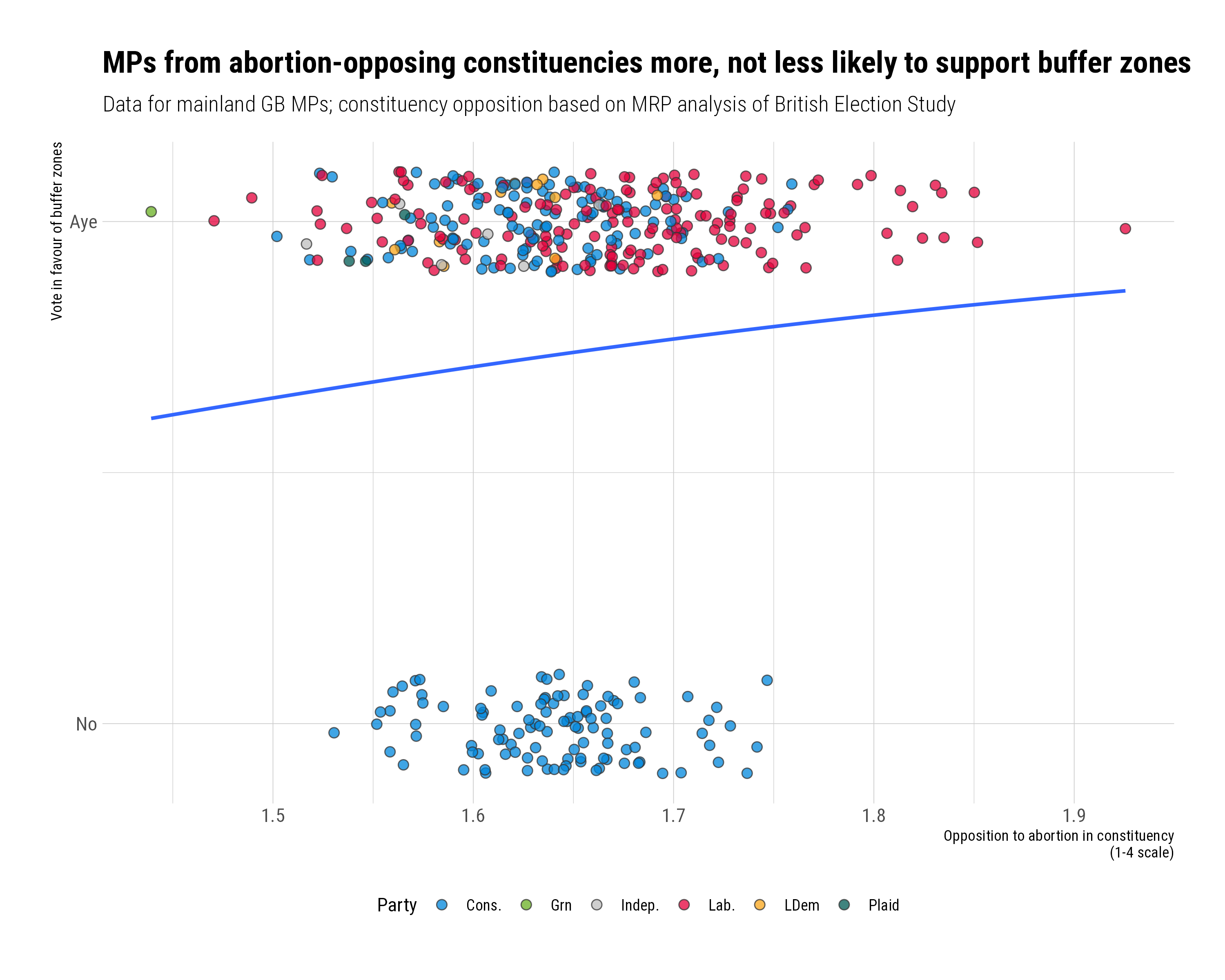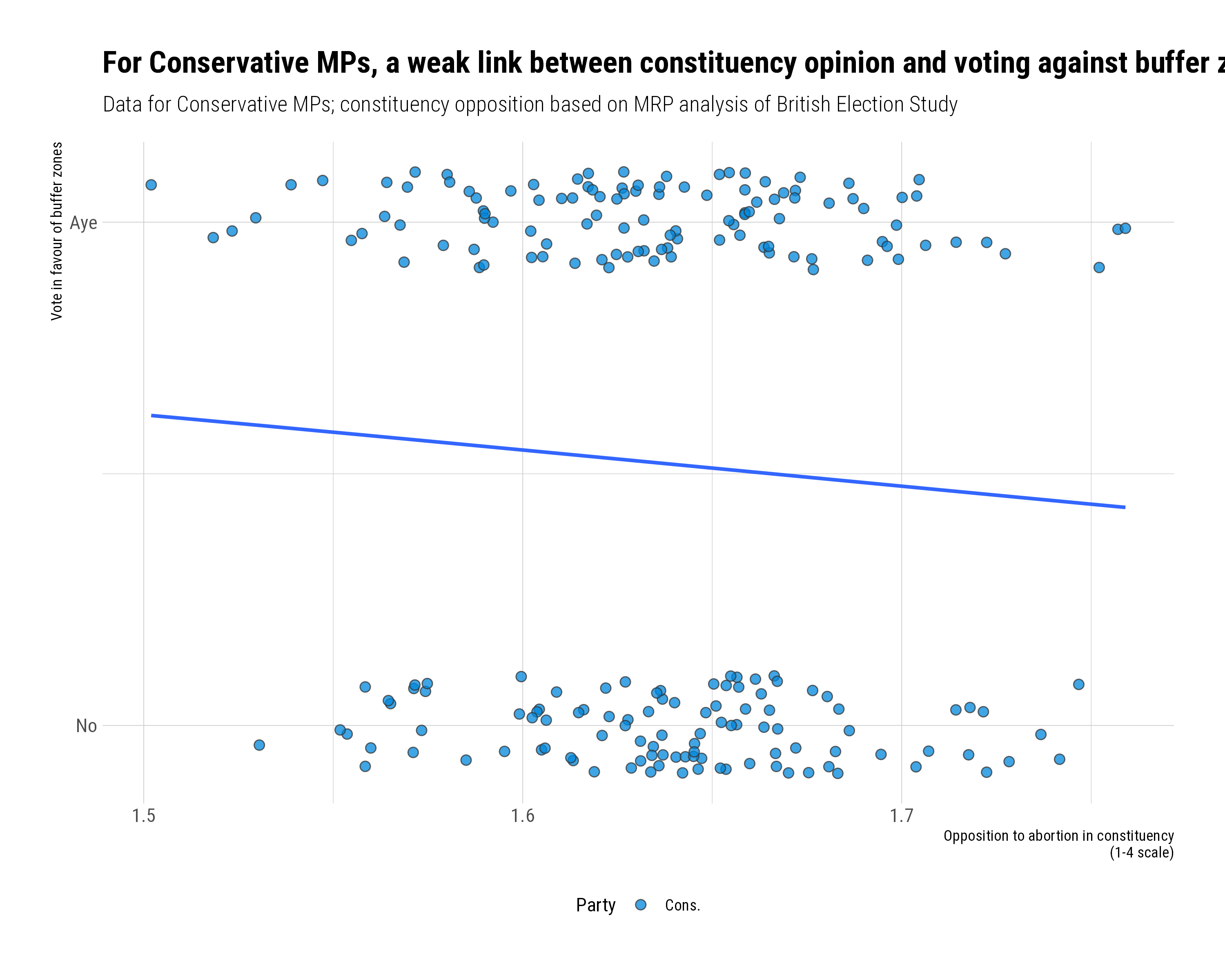The Commons vote on abortion clinics and constituency opinion
On the 18th October, the House of Commons voted on an amendment to the Public Order Bill. The amendment – new clause 11 – provides for buffer zones surrounding abortion clinics. In these zones (of 150 metres radius), protesters may not interfere with individuals’ access to abortion clinics. A plurality of MPs voted in favour of the clause (295 to 110). All those who voted against the clause came from either the Conservative Party or the Democratic Unionist Party. The vote was not whipped, and so members were free to vote on the basis of their views on protest or their views on abortion.
How, if at all, did the vote relate to opinion in MPs’ constituencies on the issue of abortion? We can gain some understanding of constituency views on abortion by looking at wave 16 of the British Election Study, which asked respondents two questions about whether it was wrong or not wrong for (i) a woman to have an abortion if there is a strong chance of serious defect in the baby; and (ii) wrong or not wrong for a woman to have an abortion if the family has a very low income and cannot afford any more children? Respondents were asked to give a response on a four-point scale, from (1), “not wrong at all”, through (2) “wrong only sometimes”, (3) “almost always wrong”, and (4) “always wrong”. The average of these two questions gives a measure of individual opinion on abortion, where higher values indicate greater opposition to abortion.
We can model these individual responses as a function of individual respondent characteristics and constituency characteristics in order to estimate average opinion in each constituency. This technique is called multilevel regression and post-stratification. The mainland Great Britain constituency least opposed to abortion is Brighton Pavilion, with a score of 1.44, or somewhere between “not wrong at all” and “wrong only sometimes”. The constituency most opposed to abortion is Birmingham Perry Barr, with a score of 1.94, very close to “wrong only sometimes”. All constituencies therefore fall on one side of the four point scale.
It might seem odd to ask how constituency opinion is reflected in a free vote, when the essence of a free vote is that members should be able to vote as their own conscience dictates, setting aside the party whip. This would seem to imply that members should also be able to vote without having regard to what their constituents think. However, there have been free votes where there was a clear association between constituency opinion and how MPs voted. This was, for example, the case in the 2013 vote on same-sex marriage. These kinds of associations can arise because MPs are, because of their initial selection or because of who they are, already in step with their constituents and do not need to be cajoled or incentivised to vote in line with their wishes.
In the vote on new clause 11, however, there was no clear association with constituency opinions and how MPs voted. When we look at all MPs (without controlling for party), the association between constituency-level opposition and voting in favour of New Clause 11 is positive, such that areas which were (speaking relatively, not absolutely) more opposed to abortion had MPs who voted in favour of buffer zones.

When we focus on the Conservative party – the only party that was divided on this issue – we see a different pattern. Now the association is in the expected direction: MPs from constituencies which were more opposed to abortion were likely to vote in favour of buffer zones. But we cannot be confident that this association is different from zero.

In a logistic regression model of voting, the change in the probability of voting for buffer zones given a move of 0.5 units (the difference between Brighton Pavilion and Perry Barr) is about (minus) twenty-three percentage points – but it could be as low as -48 percentage points or as high as +21 percentage points. We just can’t be very confident about this association.
Given the weak association between constituency opinion and how (Conservative) MPs voted on this issue, we might say either that NC11 “really was” about abortion, and that constituency attitudes on abortion displayed no clear association with how MPs behaved, or that NC11 “really was” about free speech, or at least was sufficiently closely related to issues of free speech that testing for a link with abortion opinions misrepresents the nature of the vote.
Replication data and code for this analysis are at https://gist.github.com/chrishanretty/b8edc1358a55c22871f0eb0a09d00be9; the gist contains the raw data at the top which can be copy-pasted into a spreadsheet should you wish